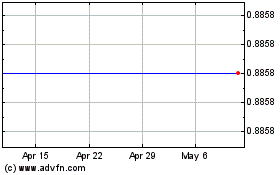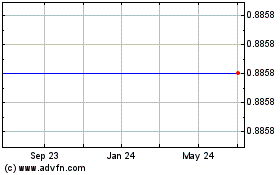The recent market tumult is a warning sign for investors to
prepare for more sharp moves ahead
By Michael A. Pollock
This article is being republished as part of our daily
reproduction of WSJ.com articles that also appeared in the U.S.
print edition of The Wall Street Journal (March 5, 2018).
As stocks have rebounded from a scary early February slide, the
up and down may be foreshadowing a new, more-volatile period for
markets.
Is your fund portfolio ready?
Advisers say there is no reason to abandon a long-term investing
strategy because of a bout of turbulence like early February's,
when stocks dropped 10% in 10 trading days. But they also say it's
a good time for investors to review how their strategy performed.
The process can shed light on how a portfolio might behave in an
even deeper downturn -- and help investors conquer their fears of
volatility by providing a clearer picture of what to expect, says
Glenn Wiggle, managing partner of Palm Beach Gardens, Fla.-based
Peak Brokerage Services.
"Understanding how a mix of assets will perform can make
investors feel more comfortable about staying the course," he
says.
Here is a look at how the recent market tumult affected funds --
including those tied directly to volatility -- and what investors
can do to prepare for more sharp moves ahead.
Put the plunge in perspective
Volatility is a normal part of investing that can be triggered
by any number of events, so investors shouldn't be surprised when
it occurs, advisers say. In the week ended Feb. 9, renewed worries
about inflation and rising interest rates ended more than a year of
relatively steady equity gains. On two separate days, the Dow Jones
Industrial Average plunged more than 1,000 points. While these were
record point moves, the declines in percentage terms weren't
historic, at 4.6% and 4.1%, respectively. The Dow, S&P 500 and
Nasdaq Composite all ended the week down more than 5%.
The tumult affected different types of funds to different
degrees, with investments designed to bet against volatility faring
especially badly.
As stocks fell, a key gauge of market stress -- the Cboe
Volatility Index, or VIX -- soared, sparking big losses for fund
investors who had been betting on continued calm. Nomura Holdings
Inc. and Credit Suisse Group AG closed exchange-traded notes that
moved inversely to the VIX after they shed more than 80% of their
value; an actively managed fund that also had bet against
volatility, LJM Preservation & Growth (LJMAX), suffered a
similarly sharp loss; and another VIX-tied exchange-traded fund
fell 88% but survived. (More on the fund tumult.)
But selling was so widespread that many conservative funds also
were affected. T. Rowe Price Dividend Growth (PRDGX) and
ClearBridge Appreciation (SHAPX), which own shares of financially
solid companies, were down about 5% that week, according to
Morningstar Direct, which tracks fund performance. Morningstar
gives both high marks for their long-term performances. "In market
panics, everything goes down," says John Lynch, chief investment
strategist for LPL Financial.
The way for investors to weather this kind of environment is to
keep an eye on the long term, advisers say. "Investors who stay
diversified, rebalance on a regular basis and stick with a plan,
and understand their downside are a lot better off in this kind of
market," Mr. Wiggle says.
That includes regularly monitoring portfolios to ensure stock
positions haven't become too concentrated or grown into a much
larger portion of total holdings than what investors have targeted.
(Advisers often suggest that if an equity allocation moves more
than 5 percentage points above an investor's long-term target, it
is time to trim it back.)
Take stock of surprises
Periods of market volatility can rattle the nerves, but they
also provide investors with an opportunity to examine how the
specific funds they own performed under pressure.
Funds that hold stocks trading at lofty valuations or that focus
on narrow market slices typically are more volatile, so it
shouldn't be a mystery if they tanked in February. Figuring out why
an actively managed fund didn't perform as expected based on its
name, style or market focus, however, requires closer scrutiny.
Aiming to beat peers as markets rallied, a manager may have
bought some hot stocks that aren't in a fund's benchmark index. A
way to gauge a fund's degree of relative risk is to compare how it
did on down days against its benchmark, which may not be the
S&P, says Chris Zaccarelli, chief investment officer of
Independent Advisor Alliance in Charlotte, N.C. If the fund
significantly underperformed its own benchmark, that could signal
that its manager is running a riskier portfolio than an investor
may be comfortable with, he says.
Understand the downside of downside protection
Low-volatility funds may seem appealing now, but may not help a
portfolio's performance if stocks continue to rally this year.
Funds such as PowerShares S&P 500 Low Volatility ETF (SPLV)
and iShares Edge MSCI Min Vol USA (USMV), which hold the
least-volatile stocks in the S&P 500, did help some investors
in the market melee.
According to CFRA, a New York-based financial data provider, the
PowerShares ETF shed 4.6% in the week ended Feb. 9, while USMV was
down 4.7%. But in return for that cushion, investors had to give up
greater gains in previous months because such strategies usually
lag behind during market rallies. Last year, for example, SPLV was
up 17% and USMV gained 19%, versus a nearly 22% gain in the S&P
500 index.
While some investors may have a good reason for buying a
low-volatility fund after a market correction, doing so could make
it harder for them to make up lost ground.
Short-term attempts to outperform the broad market won't beat a
well-designed buy-and-hold strategy over time, says Len Hayduchok,
chief executive of Dedicated Financial Services, in Hamilton, N.J.
"If you don't understand that you could lose a significant amount
in a short period, you shouldn't be in the stock market," he
says.
Prepare to bargain shop
Many investment pros believe the equity rally could continue for
a while, fueled by the recent U.S. tax cuts and strong global
growth. As such, it could make sense to shop for bargains during
another pullback.
With the Federal Reserve on track to raise interest rates this
year, investors should avoid rate-sensitive sectors such as
telecoms and utilities, advisers say. Materials and some commodity
stocks typically outperform late in market cycles, says Jay Batcha,
founder and chief investment officer at Michigan-based Optimal
Capital. But, he adds, investors should wait to buy at lower
valuations, which might result from another broad market
pullback.
Among popular ETFs in that sector are iShares Global Materials
ETF (MXI), Materials Select Sector SPDR (XLB) and Vanguard
Materials ETF (VAW).
A prudent approach would be to put money into the market
periodically, perhaps on the first of each month or quarterly, says
Mr. Lynch of LPL. Known as dollar-cost averaging, this strategy
reduces the risk that an investor will buy into a fund at a bad
time, such as right before a big correction. That said, if the
market were to fall by another 10%, investors might want to
consider moving ahead then with the next scheduled reinvestment, he
says.
Leave it to the pros
Investors who aren't experienced in decisions about individual
ETFs or allocations might consider buying an actively managed fund
that owns both stocks and bonds. Called "allocation" or
"multiasset" funds, they buy stocks when valuations are attractive
and put more into bonds when stocks get pricier.
CFRA gives high ratings to Fidelity Puritan (FPURX), which
recently had about two-thirds of its assets invested in stocks, and
Oppenheimer Capital Income Fund (OCIYX), which had a much more
conservative 34% in stocks. In the week ended Feb. 9, the Fidelity
fund shed about 3.7%, while the Oppenheimer fund was down about
2%.
Bonds probably won't perform as well in a period of rising
rates. But they still can play an important role, says Todd
Rosenbluth, CFRA's director of ETF and mutual-fund research,
generating a stream of income and reducing overall portfolio
risk.
Mr. Pollock is a writer in Ridgewood, N.J. He can be reached at
reports@wsj.com.
(END) Dow Jones Newswires
March 05, 2018 02:47 ET (07:47 GMT)
Copyright (c) 2018 Dow Jones & Company, Inc.
Credit Suisse (NYSE:CS)
Historical Stock Chart
From Mar 2024 to Apr 2024

Credit Suisse (NYSE:CS)
Historical Stock Chart
From Apr 2023 to Apr 2024
